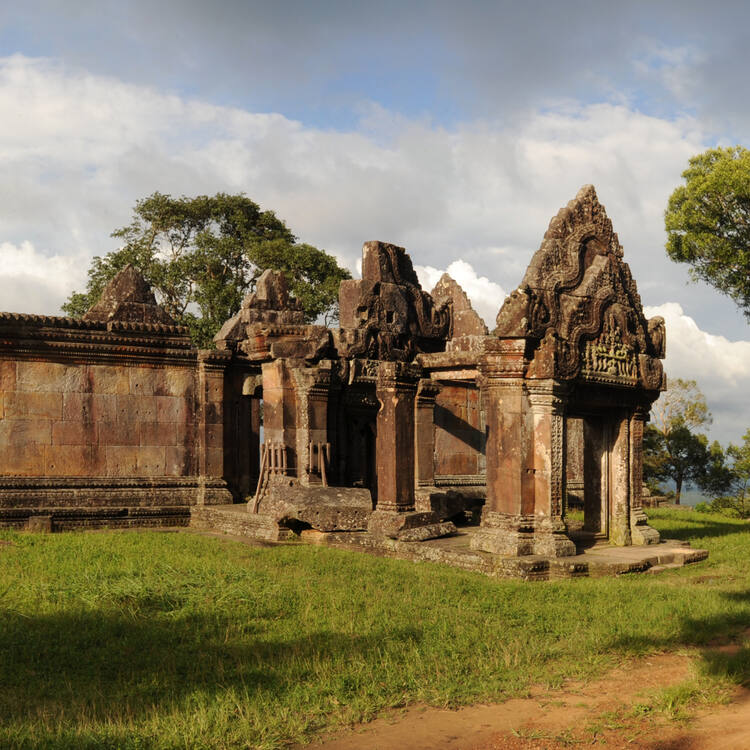Preah Vihear Temple is an old Hindu temple complex located at the top of a 525-meter cliff in the Dângrêk Mountains along the frontier between Cambodia and Thailand. The temple's history traces back to the 9th century of the early Khmer Empire. Its initial construction commenced as a Hindu hermitage consecrated largely to Shiva in his mountain forms Sikharesvara and Bhadresvara, with the oldest surviving architectural components dating back to the Koh Ker era in the early 10th century.
The temple was greatly enlarged during the times of Khmer kings like Suryavarman I (1002–1050) and Suryavarman II (1113–1150), as per changing architectural fashions and religious beliefs. With time, the site also gained Buddhist importance, as attested by the existence of a small Buddhist monastery that continues to be active nowadays.
The temple also had an important role both religiously and culturally, representing a holy mountain and cosmic axis, filled with Khmer cosmology. Its placement on a faraway cliff served to maintain it nearly intact during centuries of natural and human turmoil.

Source: UNESCO Heritage Sites
Architectural Significance
Preah Vihear Temple is remarkable for its outstanding Khmer architectural style, which significantly differs from common Angkorian temples in its prolonged north-south axis extending approximately 800 meters. The complex is organized on a sequence of terraces that rise along the cliff, representing Mount Meru, the legendary Hindu mountain.
The building has more than one sanctuary joined by pavements, stairways, galleries, and courtyards, with intricate sandstone carvings adorning lintels, doorways, and columns. The central sanctuary is placed at the highest southern corner, reached by extensive stairways with imposing naga (serpent) balustrades.
The temple is built mainly of gigantic sandstone blocks, some measuring several tons, carefully fitted to form corbelled roofs and lavishly decorated interiors.
UNESCO World Heritage Status
When it realized the temple's architectural and cultural significance, Cambodia submitted Preah Vihear Temple to UNESCO, which led to its listing as a World Heritage Site on July 7, 2008. The UNESCO listing confirms the temple's universal value as an outstanding masterpiece of Khmer architecture harmoniously incorporated with its natural surroundings, which are very rugged.
Check Out| Which Army Is Stronger, Cambodia Or Thailand? A Detailed Military And Economic Comparison
The condition of nearly pristine, its religious value, and its depiction of Khmer cosmology and artistry were all mentioned as major reasons for this designation. Nonetheless, listing also heightened the border conflict between Cambodia and Thailand, with the latter objecting to Cambodia's entry.
Territorial Dispute and ICJ Verdict
Preah Vihear Temple has been at the center of a long-running territorial dispute between Cambodia and Thailand. Both countries claimed sovereignty over the temple and surrounding areas of the Dângrêk Mountains.
In 1962, the International Court of Justice (ICJ) issued a decision that the temple itself is Cambodian and directed Thailand to remove military troops from the temple. While this decision acknowledged Cambodian ownership of the temple, it did not resolve the general border conflicts in the region, resulting in occasional tensions and conflicts.
The crisis deepened following the UNESCO designation, as Thailand objected to Cambodia's submission and saw the inscription as validating Cambodia's claims over its territorial integrity. Border clashes ensued, prompting diplomatic intervention from the United Nations and ASEAN.
In 2013, the ICJ reiterated its previous judgment, once more affirming Cambodia's sovereignty over the temple and requesting Thailand's withdrawal of military presence. Notwithstanding these judgments, certain border tensions remain, making bilateral relations and heritage conservation more challenging.
Current Status
Preah Vihear Temple is now safely under Cambodian control and can be reached mostly from Cambodia, with Thailand abiding by the ICJ decisions. The temple remains a functional religious temple with Buddhist monks performing rituals in addition to tourists visiting this one-of-a-kind architectural masterpiece.
The site continues to be a source of national pride for Cambodia and a witness to Khmer heritage, attracting thousands of foreign tourists every year. Multilateral efforts still secure peace and protect the temple's preservation alongside solutions to ongoing border sensitivities in the region.
Preah Vihear is a lasting monument at the intersection of religion, architecture, politics, and diplomacy, and it portrays the intricate legacy of Southeast Asia's common history and cultural heritage.
What's Next| Which Countries Lie In Both Europe And Asia? List of Transcontinental Countries in the World
Comments
All Comments (0)
Join the conversation